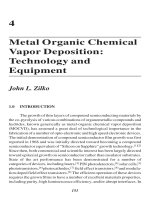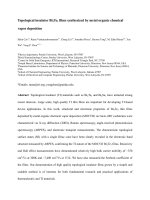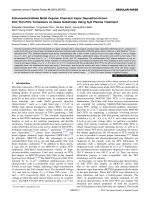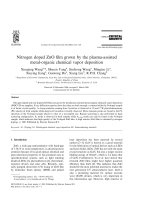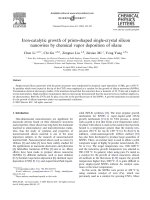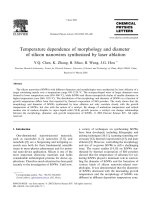- Trang chủ >>
- Khoa Học Tự Nhiên >>
- Vật lý
Silicon quantum wires arrays synthesized by chemical vapor deposition and its micro structural properties
Bạn đang xem bản rút gọn của tài liệu. Xem và tải ngay bản đầy đủ của tài liệu tại đây (273.73 KB, 6 trang )
Silicon quantum-wires arrays synthesized by chemical
vapor deposition and its micro-structural properties
M. Lu
a
, M.K. Li
a
, L.B. Kong
a
, X.Y. Guo
b
, H.L. Li
a,
*
a
Department of Chemistry, Lanzhou University, Lanzhou 730000, China
b
Laboratory of Special Functional Materials, Henan University, Kaifeng 475001, China
Received 16 July 2002; in final form 1 May 2003
Abstract
Well-aligned arrays of silicon nanowires (SiNWs) have been synthesized by a chemical vapor deposition (CVD)
template method without catalyst. The micro-structures of the SiNWs were studied by high-resolution transmission
electron microscopy (HRTEM). Selected-area electron diffraction (SAED) and X-ray diffraction (XRD) indicate that
each nanowire is essentially a single crystal and has a different orientation in an array. According to VLS mechanism,
the growth of SiNWs without catalyst is related to the structure of template. The superior field emission behavior is
believed to result from the oriented growth and the sharp tips of SiNWs.
Ó 2003 Elsevier Science B.V. All rights reserved.
1. Introduction
Quantum wires of silicon as a special form of
crystalline silicon have stimulated much interest
because of their low dimension and quantum-
confinement effect [1–4]. It has been suggested that
they may be used for developing one-dimensional
(1D) quantum wires, high-speed field effect tran-
sistors and light-emitting devices with extremely
low power consumption. In order to be capable of
being incorporated effectively into devices, these
applications usually require controlled orientation
and size of the grown nanostructure. To date, sil-
icon nanowires (SiNWs) have been successfully
synthesized by different methods, such as laser
ablation, thermal evaporation and lithography
[2–8]. However, SiNWs produced by most of these
methods are of random orientation, self-gathering
and twisting each other, which restrict their ap-
plications in nanoelectronic. Recently, a-SiNWs
were controlled grown directly on a Si substrate
via a solid–liquid–solid mechanism [9]. Liu et al.
[10] have prepared vertically aligned a-SiNWs on a
large scale on silicon oxide substrate by thermal
chemical vapor deposition (CVD). Metal catalyst
is an essential element in these methods, which is
required for the nucleation and growth of SiNWs.
In this Letter, for the first time, we employed
alumina template to prepare well-aligned SiNWs
arrays by CVD without catalyst. The size and
shape of SiNWs can be readily controlled by
the template and may vary over a wide range
Chemical Physics Letters 374 (2003) 542–547
www.elsevier.com/locate/cplett
*
Corresponding author. Fax: +86-931-891-2582.
E-mail address: (H.L. Li).
0009-2614/03/$ - see front matter Ó 2003 Elsevier Science B.V. All rights reserved.
doi:10.1016/S0009-2614(03)00747-4
according to the template used [11–14]. More im-
portantly, there are three advantages. First, tem-
plate-confined growth demonstrated to be an
efficient approach to the production of highly or-
dered and isolated nanowires arrays over large
areas. Second, it becomes possible to extend the
traditional ideas of using catalyst for the growth of
SiNWs. Third, compared with a high density of
defects near the tip of SiNWs prepared by other
methods, our present SiNWs with sharp tips and
perfect lattices might be promising materials for
future nanoprobes and superior field emitters.
2. Experimental
Alumina template was prepared by anodic ox-
idation of electropolished aluminum plate at a cell
voltage of 20 V in 0.5 M phosphoric acid at 25 °C
for 1.5 h [14,15]. After anodization, the alumina
membrane was separated from aluminum sub-
strate using the voltage-decreasing method [16].
Finally, the membrane was rinsed thoroughly with
distilled water and dried in a pure nitrogen flow.
Subsequently, the membrane was placed in a
quartz boat and then inserted into the center of a
4-cm-long quartz tube reactor heated by tungsten
filament. Atmosphere in the reactor was pumped
with a mechanical vacuum pump. A flow of H
2
(10 ml/min) and Ar (30 ml/min) was purged for
0.5 h before the reactor was heated to reaction
temperature, 900 °C. Then a flow of SiH
4
was in-
troduced at the same rate with H
2
(10 ml/min) for
1 h. After deposition, the SiH
4
and H
2
flows were
turned off, and the sample was cooled to room
temperature in an Ar atmosphere.
Before TEM characterization, the deposits on
one side of the alumina membrane were removed
by polishing with alumina power. The SiNWs were
released from the template in 6 M NaOH for 24 h,
and then thoroughly washed with distilled water.
Conventional TEM analysis and high-resolution
transmission electron microscope (HRTEM) were
both performed on a JEOL-2010 microscope at
200 kV equipped with link-ISIS energy dispersive
spectroscopy (EDS) elemental composition ana-
lyzer. SEM image of SiNWs was obtained as fol-
lowers: the sample was glued (using epoxy) to a
metallic support with the cross-section up and then
immersed into 6 M NaOH solution for 20 min in
order to dissolve alumina. The sample was then
sputtered with $10 nm of Au prior to imaging
(JSM-5600LV electron microscope). For lower
angle X-ray diffraction (XRD) study, the silicon
films on both surfaces of the alumina membrane
were removed. The sample was transferred on to
the standard silicon supporter and the spectrum
was obtained using a D/MAX-2400 X-ray dif-
fractometer.
The field emission measurements were carried
out in a vacuum chamber at a pressure of about
10
À7
Torr at room temperature. The sample was
used as the cathode, while a copper sheet polished
served as an anode. The distance between the an-
ode and the sample (cathode) surface was con-
trolled by the thickness of a mica spacer
containing a hole ($1mm
2
) in the center. Voltages
up to 3 kV were applied to the anode and the
emission current was detected with a micro-amp-
erometer.
3. Results and discussion
Fig. 1a shows the cross-sectional SEM image of
the SiNWs array after dissolving alumina. One can
see that the nanowires produced are very straight
and form a well-aligned array, indicating there are
few defects and little growth stress. As would be
expected, the nanowires are of a uniform diameter
of about 50 nm, which is consistent with the pore
diameter of the alumina template. A sharp tip is
found at the end of each nanowire, which could be
useful to a field emitter. Meanwhile, there is a
silicon surface film at the bottom of the SiNWs,
which is always presented in other nanomaterials
synthesized by template method [14–18]. Fig. 1b
shows the SiNWs are still parallel with each other
when alumina is partially dissolved, maintaining
their orientation within the template. The EDS
spectra collected from the middle part of the
SiNWs arrays (Fig. 1c) show the presence of sili-
con in addition to Al and O. C and Cu are at-
tributed to the copper micro-grid with carbon film
used to support a sample in TEM measurement.
The presence of trace of P confirms our previous
M. Lu et al. / Chemical Physics Letters 374 (2003) 542–547 543
finding that anion ions of anodizing electrolytes
are incorporated in the formation of alumina
template during the anodization procedure [19].
A single SiNW is shown in Fig. 2a, in which
alumina is dissolved completely. The selected-area
electron diffraction (SAED) pattern taken from
this SiNW is show in Fig. 2b. From this photo, it
can be seen that the diffraction spots are clear and
organized in an almost precise hexagon or paral-
lelogram, indicating that the diamond lattice
structure of bulk Si is also preserved in the SiNWs.
According to the geometry analyses of electron
diffraction, the cubic indices of the diffraction
spots in the electron diffraction pattern are de-
marcated. The similar results were obtained on the
other SiNWs, indicating that each single SiNW is a
single crystal.
In order to reveal the micro-structure of SiNWs
in detail, the HRTEM was employed to investigate
them at atomic scale. The incident electron beam is
parallel to the [1 1 0] zone axis. The HRTEM image
in Fig. 3a shows the representative micro-structural
characteristics of individual SiNWs. It is clear that
the straight SiNWs has smooth surface and the
Fig. 1. (a) SEM image of SiNWs arrays, (b) TEM image of
SiNWs arrays, (c) EDS spectrum of SiNWs arrays.
Fig. 2. (a) TEM image of a single SiNW, (b) SAED pattern of
the single SiNW, the inset data are the cubic indices of the
diffractive spots.
544 M. Lu et al. / Chemical Physics Letters 374 (2003) 542–547
change in diameter along its length is seldom ob-
served. The SiNWs are virtually defect-free and
show no kink, dislocation and small angle bound-
aries because of the periodic change growth direc-
tion along the length of the SiNWs. The growth
plane is one of the (1 1 1) planes and the fast growth
direction is along the [)2 1 1] axis of the SiNWs.
The (1 1 1) plane family, which is the densest
packed plane with the lowest surface energy in
silicon structure, hence is important for SiNWs
nucleation and growth. When the (1 1 1) planes are
parallel to the axes of the nanowires, the system
energy is reduced significantly. In this case, the
(1 1 1) planes aligned parallel to the growth axes.
Fig. 3a also shows that the tip of the SiNWs is
sharp and has a perfect lattice structure. This is in
contrast with the previous SiNWs that are round
and contain a high density of stacking faults and
micro-twins. Obviously, the sharp tip suggests a
distinctly different formation mechanism com-
pared with the previous works.
Fig. 3b shows the image of the silicon film de-
posited on the surface of the template, which has
rough surface. The interplanar spacing between
visible fringer is 0.28 nm, corresponding to the
(0 0 2) plane of silicon. It is visible that the (0 0 2)
lattice fringes are not continuous due to the dis-
location, micro-twins and stacking faults indicated
by the arrow. The film can be modeled as con-
sisting of segments with different orientation but
with a similar structure as the SiNWs. We also
notice a thin film amorphous layer exists around
the Si film, which is identified to be amorphous
silicon oxide resulting from surface oxidation.
The XRD spectrum of the SiNWs arrays in
Fig. 4 contains seven peaks, which are identified to
match well with the (1 1 1), (2 2 0), (3 1 1), (4 0 0),
(3 3 1), (4 2 2) and (5 1 1) diffraction peaks of the
diamond lattice structure of bulk silicon through
the PCPDFWIN software. The other unmarked
peaks are assigned to the alumina. Calculated
from the interplanar spacing of the most intense
(1 1 1) peak (d ¼ 0:3147 nm), the lattice parameter
of the SiNWs can be obtained as a
SiNWs
¼ 0.5451
nm, which is 0.387% larger than the standard value
a
Si
¼ 0.5430 nm for bulk silicon, revealing there is
a slight lattice expansion and distortion in the
SiNWs structure. From the XRD results, the array
of SiNWs appears to be polycrystalline structure,
which seems contradicting to the above results of
SAED. This can be understood that the statistical
results obtained by the XRD pattern and the dif-
fraction patterns of different whiskers indicate
different orientations.
The growth of SiNWs catalyzed by metal parti-
cles is usually considered to be a vapor–liquid–solid
Fig. 3. Typical HRTEM images of SiNWs (a) and Si film de-
posited on the surface of SiNWs arrays. Fig. 4. XRD spectrum of SiNWs arrays.
M. Lu et al. / Chemical Physics Letters 374 (2003) 542–547 545
mechanism. However, it is clear that the conven-
tional VLS mechanism based on the role of cata-
lyst [20–22] could not explain the growth of
SiNWs, because we did not use any catalyst in the
deposition. We propose the following mechanism.
During the early stage of the CVD process, most
of the silicon atoms were originated from the dis-
sociation of silane at high temperature. There are a
large of Lewis acid nature of surface sites in
amorphous and transition alumina and these sites
have the intrinsic catalytic activity of transition
alumina in front of the decomposition of silane
[23]. Therefore it is possible that the internal
channel surface within alumina has a catalytic
behavior in addition to its template effect. Most
silicon atoms in vapor phase will be deposited on
the walls of alumina nanochannels. The high
density of dangling bonds at the surface of atomic
Si will lead to the bonding each other between
silicon atoms and a continuous diffusion into the
channels of alumina. Further condensation will
then produce SiNWs in the channels of alumina.
Furthermore, the carrier gas Ar will collide with
the pore surface and the atomic Si has absorbed
and exchange energy and momentum with the
atom, causing overcooling at the surface. Because
the precipitation, nucleation and growth of SiNWs
always occurred at the area near the cold fringer,
such an overcooling is important for providing
temperature gradient used as an external driving
force for nanowire growth. However the reason
for the formation of sharp tip on the SiNWs is not
clear yet, further work is required to understand
this phenomenon.
ZhangÕs has demonstrated SiNWs emitters dis-
play attractive field emission properties, which
may be exploited for practical applications [24].
Fig. 5 illustrates the curve of current versus voltage
(I–V curve) for SiNWs arrays, revealing the ro-
bustness of the emission process from the emitter.
The turn-on field for electron emission, defined as
the macroscopic fields needed to produce a current
density of 0.01 mA/cm
2
,is$14 V/lm. The I–V
data analyzed by the Fowler–Nordheim theory
[25] is presented in the inset of Fig. 5. As can be
seen, almost straight line is obtained, indicating
that the field emission from SiNWs is a barrier
tunneling quantum mechanical process. The
superior field emission behavior is believed to
originate from the sharp tips and oriented growth
of SiNWs.
4. Conclusion
In conclusion, the morphologies and micro-
structures of well-aligned SiNWs arrays synthe-
sized by CVD template method were investigated
by electron microscopy. It is found from the re-
sults of SAED that each nanowire is a single
crystal, while XRD suggests that SiNWs have
different orientation in the array. The growth
mechanism of SiNWs without catalyst was dis-
cussed based on the function of the alumina tem-
plate. In addition, field emission measurements
show that ordered SiNWs arrays with perfect lat-
tice would be very useful for field emission and
other nanoelectronic device applications.
Acknowledgements
This work is supported by the National Natu-
ral Science Foundation of China (Grant No.
60171004).
Fig. 5. Current–voltage characteristics of SiNWs arrays (inset:
Fowler–Nordheim plot of SiNWs arrays).
546 M. Lu et al. / Chemical Physics Letters 374 (2003) 542–547
References
[1] A.M. Saitta, F. Buda, P.V. Giaquinta, Phys. Rev. B 53
(1996) 1446.
[2] A.M. Morales, C.M. Lieber, Science 279 (1998) 208.
[3] D.P. Yu, C.S. Lee, I. Bello, Solid State Commun. 105
(1998) 403.
[4] J.Y. Yu, S.W. Chang, J.R. Heath, J. Phys. Chem. B 104
(2000) 11864.
[5] H. Namatsu, S. Horiguchi, M. Nagase, K. Kurihara, J.
Vac. Sci. Technol. B 15 (1997) 1688.
[6] Y. Wada, T. Kure, T. Yoshimura, Y. Sudou, T. Kobay-
ashi, Y. Gotou, S. Kondo, J. Vac. Sci. Technol. B 12 (1994)
48.
[7] T. Ono, H. Saitoh, M. Esashi, Appl. Phys. Lett. 70 (1997)
1852.
[8] Z. Zhang, X.H. Fan, L. Xu, C.S. Lee, S.T. Lee, Chem.
Phys. Lett. 337 (2001) 18.
[9] H.F. Yan, Y.T. Xing, Q.L. Hang, D.P. Yu, Y.P. Wang, J.
Xu, Z.H. Xi, S.Q. Feng, Chem. Phys. Lett. 323 (2000) 224.
[10] Z.Q. Liu, W.Y. Zhou, L.F. Sun, D.S. Tang, X.P. Zou, Y.B.
Li, C.Y. Wang, G. Wang, S.S. Xie, Chem. Phys. Lett. 341
(2001) 523.
[11] C.B. Gorman, H.A. Biebuyck, G.M. Whitesides, Chem.
Mater. 7 (1995) 526.
[12] G. Che, B.B. Lakshmi, C.R. Martin, E.R. Fisher, Chem.
Mater. 10 (1998) 260.
[13] T. Kyotani, B.K. Pradhan, A. Tomita, Bull. Chem. Soc.
Jpn. 72 (1999) 1957.
[14] D.H. Qin, M. Lu, H.L. Li, Chem. Phys. Lett. 350 (2001)
51.
[15] Y.K. Zhou, H.L. Li, J. Mater. Chem. 12 (2002) 681.
[16] S.L. Pan, D.D. Zeng, H.L. Zhang, H.L. Li, Appl. Phys. A
70 (2000) 637.
[17] M. Lu, X.H. Li, H.L. Li, Mater. Sci. & Eng. A 334 (2002)
291.
[18] C.W. Wang, M.K. Li, H.L. Li, Sci. China A 44 (2001) 234.
[19] M. Lu, D.H. Qin, H.L. Li, Lanzhou University Press 38
(2002) 47.
[20] R.S. Wager, W.C. Ellis, Appl. Phys. Lett. 4 (1964) 89.
[21] R.S. Wager, C.J. Doherty, J. Electrochem. Soc. 115 (1968)
93.
[22] K.K. Lew, C. Reuther, A.H. Carim, J.M. Redwing, B.R.
Martin, J. Vac. Sci. Technol. B 20 (2002) 389.
[23] P.O. Scokart, P.G. Rouxhet, J. Colloid Interface Sci. 86
(1982) 96.
[24] F.C.K. Au, K.W. Wong, Y.H. Tang, Y.F. Zhang, I. Bello,
S.T. Lee, Appl. Phys. Lett. 75 (1999) 1700.
[25] R.H. Fowler, L.W. Nordheim, Proc. R. Soc. Lond. Ser. A
119 (1928) 173.
M. Lu et al. / Chemical Physics Letters 374 (2003) 542–547 547
